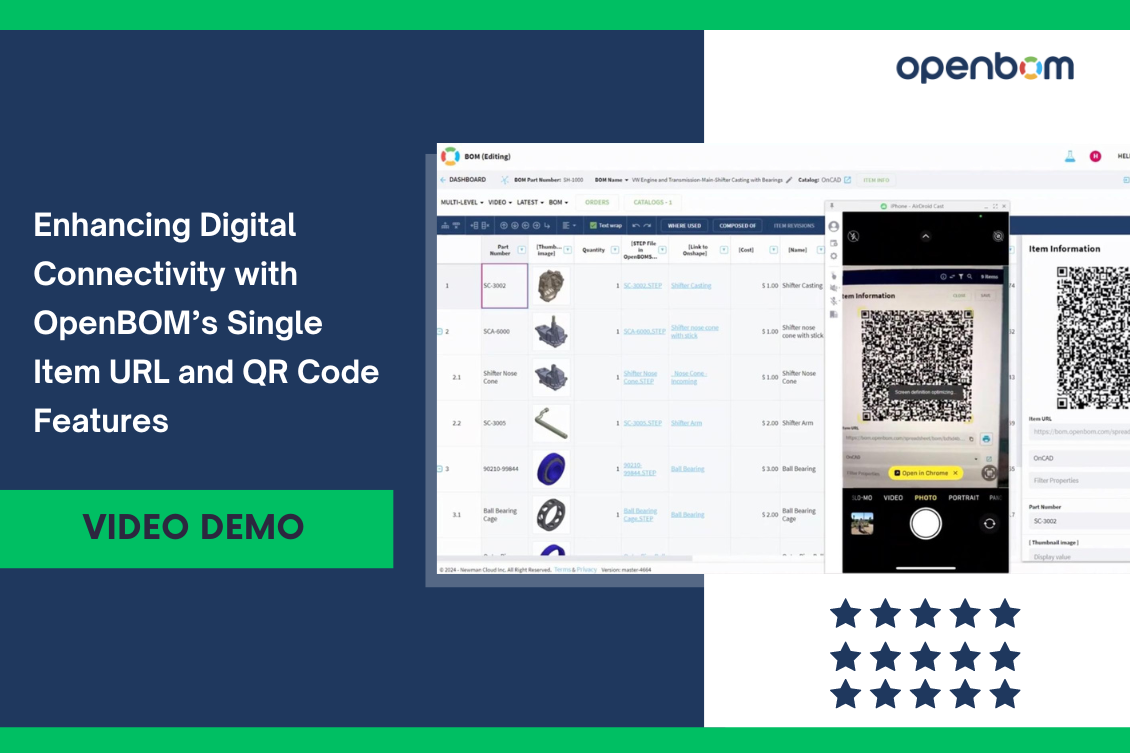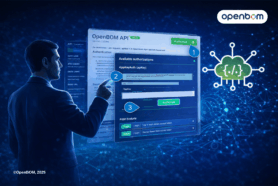
In today’s fast-paced digital world, seamless connectivity and efficient access to data are crucial for successful operations, especially in manufacturing and engineering environments. OpenBOM’s latest features—the Single Item URL and QR Code support—are designed to significantly enhance the ease of connecting with and managing your data, whether you’re working within digital systems, physical environments, or mobile devices.
1. Single Item URL: A Versatile Link Across Multiple Systems
The Single Item URL is a key feature that simplifies the way you connect OpenBOM data with other digital systems. Traditionally, accessing and editing item information required navigating through an entire catalog within OpenBOM. Now, with the Single Item URL, you can directly link to specific items from various platforms like JIRA, ERP, CRM, and more.
This integration capability is a huge improvement for cross-functional teams. For instance, if your engineering team uses JIRA for issue tracking, the Single Item URL allows them to link specific parts or components directly to JIRA tickets. Similarly, your procurement team can easily connect items to ERP systems for streamlined ordering processes, and your sales team can link to product details in CRM systems, ensuring that all relevant information is just a click away.
This connectivity not only improves efficiency but also reduces the risk of errors, as it ensures that all stakeholders are working with the same up-to-date information, regardless of the system they are using. The Single Item URL breaks down data silos, making it easier for teams to collaborate and stay aligned.
2. QR Code: Bridging the Gap Between Digital and Physical Interfaces
The introduction of QR Code support in OpenBOM further expands your ability to connect digital data with physical environments. Each item in OpenBOM now has an automatically generated QR code that can be printed and attached to physical products, components, or packaging.
This feature is particularly valuable in manufacturing, warehousing, or field operations where quick access to item information is essential. For example, a technician working on a machine can scan the QR code on a component to instantly access detailed specifications, maintenance history, or replacement parts. Similarly, in a warehouse, scanning the QR code on a product can bring up its inventory status, shipping details, or quality control records.
By linking physical items directly to their digital counterparts in OpenBOM, the QR Code feature streamlines workflows, reduces the likelihood of errors, and enhances traceability throughout the product lifecycle. This physical-to-digital connection ensures that your team can access critical information exactly when and where they need it, improving both productivity and accuracy.
3. Mobile Browser: Simplifying the Editing Process on the Go
The ability to edit item information on the go is becoming increasingly important as more professionals rely on mobile devices for their work. OpenBOM’s Single Item URL and QR Code features are fully optimized for mobile browsers, making it easier than ever to manage your data from any location.
With the Single Item URL, you can quickly access and edit specific items directly from your mobile device. Whether you’re in a meeting, on the shop floor, or traveling, the mobile-friendly interface ensures that you can make updates, add notes, or review details without the need for a desktop or laptop. This convenience is a significant improvement over the previous method, which required accessing the entire catalog—a process that could be cumbersome on smaller screens.
The QR Code feature complements this by allowing you to scan codes with your mobile camera, bringing up the relevant item directly in your browser. From there, you can edit information, check statuses, or make decisions in real time, all from your mobile device. This flexibility is invaluable for professionals who need to stay connected and responsive, no matter where they are.
Video Demo: See the New Features in Action
We’ve prepared a video demonstration that walks you through the capabilities of the Single Item URL and QR Code support in OpenBOM’s
In this demo, you’ll see:
- Single Item URL: automatic generation of QR code setup
- Editing of a single item: navigate to a single item in the browser for link and edit
- Mobile Editing: An overview of how the Single Item URL and QR Code features enhance mobile usability, allowing you to edit item information on the go with ease, directly from your mobile browser.
Watch the Video Demo Now to see how the Single Item URL and QR Code features can elevate your workflow and improve your team’s efficiency.
Conclusion: Elevating Connectivity and Efficiency
OpenBOM’s new Single Item URL and QR Code features represent a great improvement in digital connectivity and data management provided by OpenBOM. By enabling easy integration across multiple systems, bridging the gap between digital and physical interfaces, and simplifying the editing process on mobile devices, these features empower teams to work more efficiently and collaboratively.
Whether you’re linking item data in a digital system, scanning a QR code in a physical environment, or making quick edits on the go, OpenBOM provides the tools you need to stay connected and keep your operations running smoothly.
REGISTER FOR FREE and explore these features today and experience the future of item management with OpenBOM.
Best, Oleg
Join our newsletter to receive a weekly portion of news, articles, and tips about OpenBOM and our community.










